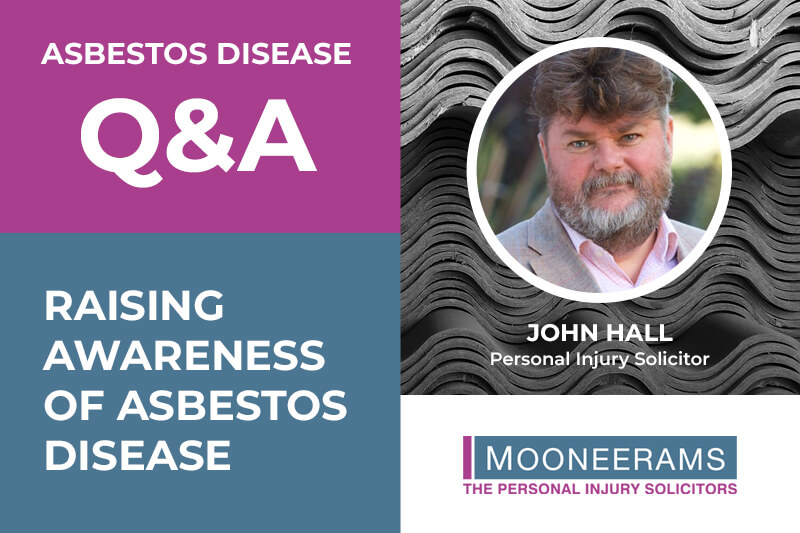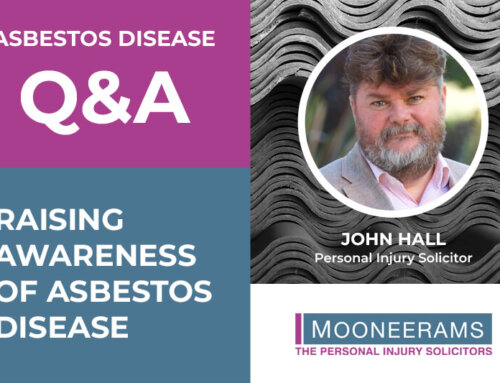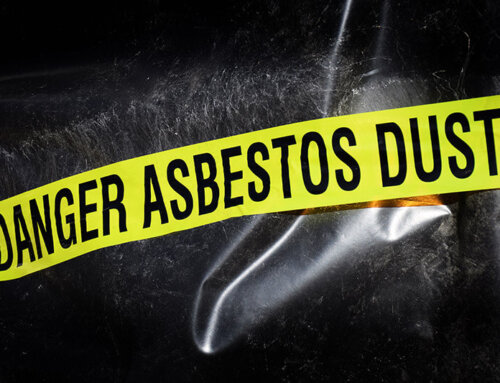This is the final blog in a series of seven which was written after we held a Q&A with asbestos solicitor, John Hall, who handles asbestos claims on behalf of Mooneerams.
To see the rest of the blogs in this series go to the asbestos disease section on our dedicated Blog page. During this final part of our discussion with John, we asked him a few questions about:
Whether we are nearer to a cure,
When if ever we’ll see the eradication of asbestos from the UK,
What his average day is like as an asbestos disease solicitor and, importantly,
What John’s advice is to those people who worked with asbestos many years ago, who aren’t displaying any symptoms of asbestos disease, but are nevertheless worried about getting an asbestos illness.
Are we anywhere near to finding a cure for asbestos disease?
No sadly not, we are nowhere near a cure. All these conditions we have covered are untreatable really. There are encouraging developments in mesothelioma cases where treatments like immunotherapy treatments are having some results.
However, what these treatments tend to do is prolong life, offer palliative care so that they will reduce the symptoms and extend somebodies life expectancy – that is, if they work; but they do not always work.
Over the years there have been some speculative treatments including the removal of lungs etc., but these have not been entirely successful. There is a lot of research going on in the area of asbestos disease in the hope that there will be a cure but there is no magic bullet on the horizon.
Are we close to getting rid of all remaining asbestos in this country?
The thing to remember with asbestos is that it is only dangerous when it has been disturbed. You can drive up and down the country and see farm buildings that still have asbestos within them in the form of corrugated sheets etc.
Asbestos can still be seen on the roofs of garages and in the roof of buildings against gable ends – a lot of buildings still contain some asbestos.
If asbestos is not disturbed, then there should be no problem with it, and it will not pose a health threat to anyone near it.
However, if it is disturbed and people do not follow the proper procedures then there are still risks of being exposed to asbestos.
People’s knowledge is somewhat better than it used to be but also regulations are now much tighter than they were previously. So certainly, in the workplace environment I would expect there to be little or no exposure to asbestos after the year 2000, so inevitably we are going to see a drop in those cases.
That said, I have been working as an asbestos lawyer for 30 years plus and we have expected a decline for some time, but there has not been quite the drop off in cases that we would want and expect.
So, there has been a slow decline, but I would suspect that we will not eradicate asbestos disease for a good 20-30 years because of the historical nature of the exposure. People could have been exposed in the 1960s and 1970s and still not have any outward symptoms at this stage. It is likely that people were still being exposed in the 1980s and 1990s and they may not see any symptoms now but may well do in the future. The reality is that we are getting there but the decline is not as rapid as we had all anticipated.
What is your average day like as an asbestos specialist solicitor?
No two days are the same; they are busy and varied, trying to locate defendants and insurers, dealing with witnesses and of course my clients, looking at medical records, and medical reports. There are so many aspects to any one day.
Taking statements, which is an integral part of the claim, can take up to two days to do. For my asbestos clients, to take statements and go over all aspects of their claim with them, I do home visits and that can take me all over the country. (Obviously COVID was a big problem then and we had to resort to taking instructions over the phone during that time). It takes so long as we have to be very precise in getting everything accurately documented.
What advice would you give to someone who has historically worked in a power plant, steel works pr other heavy industry some years back and is now worried because they are sure they worked with asbestos but at present are displaying no symptoms?
I speak to people about just this aspect on a regular basis and I always tell them if you have any symptoms that you cannot explain, i.e., it is not hay fever and is not asthma and you are worried about it the symptoms you have, go, and see your GP.
When you are there, mention that you were exposed to asbestos; there are protocols in place and normally a GP will refer you on for a chest X Ray.
From the result of the X Ray, it should be very clear if there was exposure to asbestos. If you suffered exposure, you would expect there to be evidence of at least pleural plaques and if that’s the case it will alert the doctors to refer you onto a specialist.
The sort of symptoms I would expect to see in someone who has asbestos illness, would typically be shortness of breath, persistent cough (dry rather than anything else), weight loss, constant tiredness, and loss of “get up and go”. Most of all I would expect there to be breathing difficulties.
If you are worried that you may have been exposed to asbestos, because of the kind of work you used to do, call us in confidence on 029 2048 3615 and to arrange an informal discussion with our asbestos disease solicitor.
Read more in our Asbestos Disease Q&A series:




